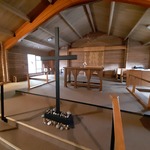For a while, in my twenties, I lived in a small community just outside Moose Jaw in Saskatchewan. As you can imagine, the landscape in Saskatchewan is quite different from Lynn Valley. I remember one Easter, standing along a dirt road on the outskirts of town for a sunrise service. The idea was to mark the passage from Good Friday to Easter by waiting for the sun to pierce the night sky.
I remember it had been a particularly difficult year: illness in my family; I’d been through a tough break up; and as I entered my last year of University, I wondered if the career path I was on was really meant for me after all.
As I looked out that morning, waiting for the sun to come up, there was something simultaneously haunting and comforting about the vast expanse of space before me. On the one hand, it was quiet, and calm; I liked that you could see for miles, that there weren't mountains or forests or skyscrapers dominating the landscape. On the other hand, it was cold, and vacant, and lonely.
There is a concept in visual art, maybe you’ve heard of it, it’s called positive and negative space. Positive space is anything in a piece of art that takes up space—whether it’s an object, or colour, or shading. If we take a moment to hold up our hands, we can see that if our hands were a painting, our fingers and our palms would be taking up positive space.
The opposite or the complement of positive space is negative space. Negative space is anything where there is an absence of an object, an absence of colour or shading. Sometimes called “white space”, negative space is the area around an object or a figure. If you hold up your hand again, negative space is that area between your fingers—you can see it and you can almost feel it, too.
Normally, there is a lot of positive space in this church. Normally, we have colourful hangings on the altar, normally there are banners, and brass, and silver vessels. Today, maybe you’ve noticed that the church has a lot more negative space than usual. The altar has been stripped, all of the hangings in the church have been removed.
Now, what remains is a dark, black, cross waiting at the back of the church and a small silver ciborium on the altar, which holds consecrated wafers—the body of Christ. If we trace our eyes around the spaces in the altar, like we did with our hands, we can see just how much negative space is in the atmosphere today.
I draw your attention to positive and negative space because this imagery speaks to the themes of presence and absence, of comfort and haunting throughout our Good Friday readings, throughout Jesus’ final journey to the cross: his arrest, his sentencing, his crucifixion, and his death.
For example, Jesus goes with his disciples to a garden where he is hoping to find some reprieve, a chance to get away from it all. Instead, he is met there by his close friend, Judas, and a group of soldiers and police sent by the chief priests. They arrest Jesus. They bind him. They take him in to the authorities.
Meanwhile, people are questioning another one of Jesus’ good friends, Peter. And they’re saying, “Hey, you know this guy, don’t you?”
We might expect Peter to say, “He is my Lord and my God!” Instead, he says, “Nah, never heard of him.”
When Jesus is brought before Caiaphas the high priest and Pilate the Roman governor, again, we are hoping for some way out for Jesus. Pilate even seems to be looking for a loophole, some negative space in the law where Jesus can slip through. But, presented with the opportunity to set him free, Jesus’s own community chooses instead to release a criminal.
Finally, as Jesus hangs on the cross he seems to come face to face with a question we all come to terms with at some point in our lives: “My God, My God, why have you forsaken me?”
O God, why are you absent?
Jesus’ words of abandonment on the cross seem to me a profound example of negative space, that tremendous sense of emptiness when we go looking for God and we don't find them.
Of course, in the Christian story there is a greater example of negative space still to come: that of an empty tomb where Jesus is supposed to be dead and buried. Jesus’s disciples are expecting to find a body and they find instead a pile of clothes. We learn that tucked inside the seeming absence of an empty tomb is the promise of resurrection. So also on this Good Friday, tucked inside our own experiences of absence, of abandonment, of negative space, we find, paradoxically, the promise of something else.
To befriend the negative space in our selves, in others, in our world, and yes, even in God, is to befriend abandonment, to befriend absence, to befriend death—to strip it of its power and to see it for what it really is: the promise of sunrise, the promise of resurrection waiting for home.






